|
Established
in 1908, AC is the oldest British car manufacturer that is still making
vehicles today. The AC name came from the name of their first
commercial 3-wheeler; The Autocarrier; that was designed and
manufactured by John Weller. He previously had his own business in
South London (UK) in 1903 making the Weller car but this was not a great
success.
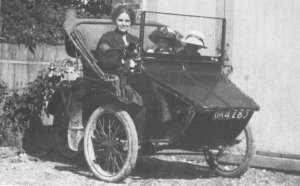
The
1914 AC Sociable
The
Autocarrier was built as a small delivery van and became very succesful.
It was also very fashionable the time for companies to have at least one
Autocarrier as a delivery van. lIn 1908 a new a passenger version that
was called the AC Sociable was introduced. The name came from the
fact that the passenger and driver's seat were side by side and not in a
tandem design as with many other 3-wheelers at the time and it was also
the first time that the initials AC were used. The British Army also
used AC Sociables due to their reliabilty and they were fitted with
customized bodywork that acted as machine gun carriers.
During
the First World War AC continued to produce vehicles as well as shells
and fuses. By 1919 they were back in full car production again.
The new Models were now produced with 10 and 12 hp engines and were
later replaced by a six-cylinder 16hp model. For the next few
years AC turned to producing 4-wheeled vehicles and did not produce
another 3-wheeler until 1953 with the AC Petite. The Petite was powered
by a 346cc single cylinder two-stroke Villiers engine and had an
aluminium body fastened to a light steel frame. The cars however were
not a great success. Despite their price of £400 the car looked like
the government-sponsored invalid cars that AC also made and so the
Petite were not widely accepted. Production continued until 1958, though
AC continued to make invalid cars until the early 1970's when AC then
concentrated on just 4-wheelers again.
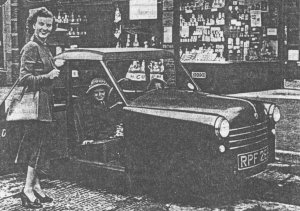
The
1953 AC Petite
THE
AC COBRA
A
special chapter in the Cobra's history is it's racing career. Racing
driver Carroll Shelby conceived the Cobra with the intention to win
races with it to generate good publicity for the car and kindling sales.
These days the popular myth is that the Cobra dominated GT racing in its
days, but this is, like all myths, not completely true.
In the US the Cobra roadsters did particularly well in local races for
practically a decade. There it took full advantage of its favorable
power to weight ratio and its sprinting capacities on the relatively
short tracks. In international production car races however it was less
than successful. During the 1960s the time that open roadsters were
competitive in top level racing had passed and high maximum speeds and
therefore aerodynamics became more important. The cars to beat were all
coupes with much better shapes to slice trough the air.
This became very clear during Shelby's first attempt at the Le Mans race
with the Cobra in 1963. Two Mk II Cobras were entered, one prepared by
Ed Hugus and one by AC Cars, both fitted with hardtops to reduce drag on
the long Mulsanne straight. Only the right hand drive AC entry
(resembling the car you see here) survived at the end and finished 7th,
beaten by 6 Ferraris. The conclusion was that the roadster lacked top
speed to win races on the longer international circuits.
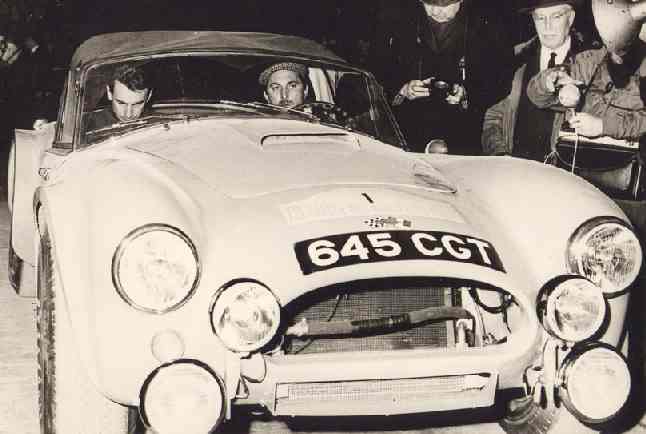
The Cobra is a high powered, hand crafted aluminium bodied sports car of
the 1960's . Its creation, production and ongoing development being the
result of joint Anglo American co-operation between Carroll Shelby, AC
Cars Limited and The Ford Motor Company. The AC/Shelby/Ford Cobra was a
huge success. The combination of British craftsmanship, Ford Power and
Carroll Shelby's foresight, determination and racing successes made the
Cobra famous and today ranks among the most collectible and valuable of
classic motor cars. Today's AC Cobra is still entirely hand made by the
same traditional British coach-building methods used by AC Cars in the
1960's and utilising the same original Cobra tooling. Each part is
painstakingly hand crafted to the highest possible standards from the
aluminium outer body to the leather trimmed interior. The Cobra name and
Trademark were sold to Ford Motor Company by Carroll Shelby in 1965 and
AC Cars are the only Company in the world licenced by Ford to use the
famed Cobra Trademark and name on their product.
|
AC
COBRA ENGINE SPECS
|
|
Manufacturer
|
Ford
|
|
Configuration
|
V8
|
|
Capacity
|
4942
cc (302 cu in)
|
|
Bore
|
101.6
mm (4.0 in)
|
|
Stroke
|
76.2
mm (3.0 in)
|
|
Compression
ratio
|
9.0:1
|
|
Valve
gear
|
OHV
|
|
Aspiration
|
Electronic
fuel injection
|
|
Power
(DIN/rpm)
|
225
bhp @ 4200 rpm
|
|
Torque
(DIN/rpm)
|
300
lb ft @ 3200 rpm
|
|
Power
to weight ratio
|
200
bhp per ton
|
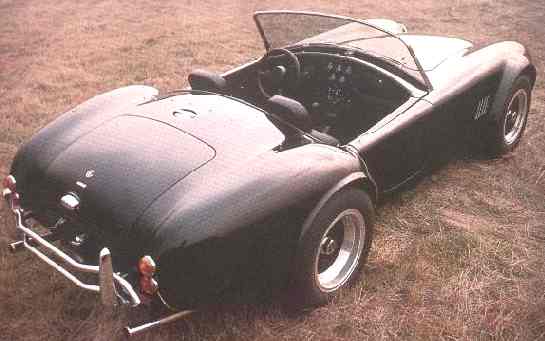
The
AC Cobra
After
the disappointing finish at Le Mans Ford and Shelby decided to
concentrate their international racing efforts on the Lola based GT40
project. The GT40 still needed a lot of development and to fill the gap
until the GT40 could be entered competitively Shelby agreed to a
proposal by young designer Peter Brock to create an aerodynamic coupe
body on the chassis of the Cobra 289. This option had occurred as a
result of a recent change in FIA homologation rules for GT racing cars.
Now
it had become possible to either change the body or the chassis of the
car without making another 100 examples of it to qualify it as a GT car.
The intention of this was to make slight enhancements possible for small
manufacturers taking part in the series, like fitting wider tires or
extra air intakes, but there were no exact boundaries defined. This made
fitting the sleek GTO body on the 250 GT berlinetta chassis possible for
Ferrari and Brock envisioned something similar for the Cobra 289.
A small development team was formed by Brock, racing driver and engineer
Ken Miles and mechanic John Olsen and in September 1963 work on the
Cobra coupe started. The objective was to wrap an aluminium body as
tightly as possible around the Cobra's underpinnings to reduce frontal
area, to make it cut through the air and yet to meet FIA regulations
regarding windows, windshield, spare tire and so on.
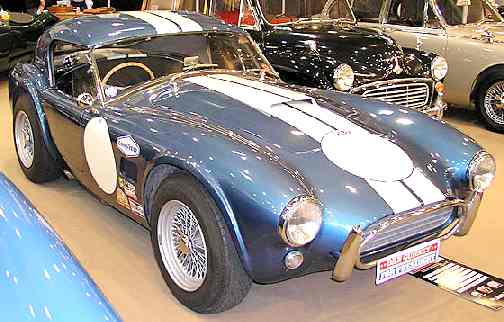
AC
Cobra Le Mans Replica 1964
Then
a winning spree of almost 2 years started with a successful 1964 Le Mans
race. Two Daytona coupes were entered and they were so quick that they
left all competition behind and ran with the cars in the faster
prototype class. Drivers Dan Gurney and Bob Bondurant took 4th overall
and 1st in the GT class, defeating the magnificent Ferraris 250 GTO.
More victories followed but after cancellation of the Italian Monza race
the Cobra Daytona coupe just nearly missed the GT World Championship
crown which was snapped up by Ferrari's 250 GTO.
Ferrari didn't compete in the 1965 GT World Championship, lacking a car
to beat the mighty Cobra Daytonas. The Daytona coupes, entered by Alan
Mann racing from Britain as Shelby was busy with the GT40 programme,
then dominated on the international circuits, scoring victories in 8 of
the 10 championship races. The 1965 Manufacturers Championship was
easily won.
After the 1965 season Ford and Shelby lost all interest in the Cobra
Daytona coupe, since they were moving on with the GT40 effort and didn't
want in-house competition from the Daytona coupe. The coupes were left
in England with Alan Mann but under a threat of a large tax fine (the
cars never being officially imported) they were flown back to Shelby in
the US who had a hard time selling them. It took a few years to get rid
of them at prices of around 5000 US Dollars.
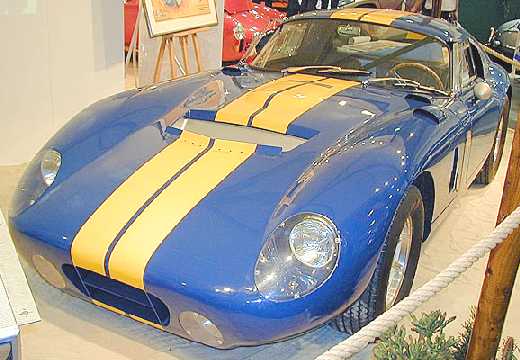
AC
Cobra Daytona Coupe 1964
That
last bit is hard to believe nowadays. The Daytona coupes are the most
valuable of all original Cobras, each of them worth over a million US
dollars, at least ten times as much as a Cobra roadster. And rightfully
so, it's a beautiful beast looking like it is all coiled for a huge jump
forward and it's packing an enormous punch. The Daytona coupes are
largely responsible, certainly outside the US, for the Cobra's fabled
racing heritage in which the "regular" Cobra roadsters played
a minor part. In that respect it's a pity that there wasn't a street
version developed of the Daytona coupe, sort of like a reinvented AC
Aceca, at the right time it might have rendered the Cobra an image
similar to that of Ferrari instead of being a specialty car.
Never the less, the Cobra became an icon. It may have its flaws, like
being impractical, difficult to control (especially the 427) and lacking
chassis rigidity, its uncompromising nature, appealing looks and
unsurpassed dynamic sensations more than make up for that. There are far
more enthusiasts than original Cobras, so expect a substantial price if
you want to obtain one.
THE AC ACE
The
new AC Ace model received rave reviews from the motoring press in 1995
but never entered full production. Its design is now being revised to
meet safety and environmental regulations and offer even greater driving
enjoyment.
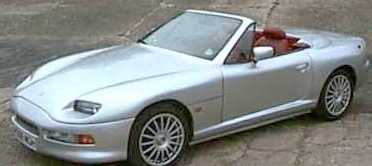
AC
Ace
The
latest AC Ace has been designed and developed not only to meet the
rigorous and exacting safety and emission requirements of the EEC and
North America, but also to provide an aerodynamically stable,
long-lasting vehicle that is both practical and remarkably easy to
drive. Yet, at the same time, it has the exciting performance and
handling characteristics of the almost forgotten golden age of powerful
front-engined British sports cars. The massive construction of the
stainless steel alloy monocoque-type chassis, together with the
aluminium outer body panels, provide an immensely rigid and
corrosion-resistant platform to mount the race-inspired suspension, ABS
controlled ventilated power disc brakes and variable-ratio
power-assisted steering. Sacrificial crash structures and hydraulic rams
are incorporated into the front and rear of the monocoque, capable of
progressively absorbing substantial impact without damage to the main
chassis and cockpit areas whilst extensive door beams protect driver and
passenger from side impact.
Wide-based
unequal-length wishbones, gas-filled dampers (twin at the rear) and
concentric coil springs impart the traditional firm feel of a powerful
sports car without impairing ride quality or transmitting vibration and
harshness into the cabin. Though front engined, a 50/50 front/rear
weight distribution has been achieved to provide precise and balanced
handling that both reassures and rewards the driver. The ACE's 5.0 litre
EFI catalytic V8 engine, coupled either to the 5-speed manual or the
optional 4-speed automatic transmission, allows effortless acceleration
up to a top speed in excess of 140mph. At the same time, 28 Tclean'
miles per imperial gallon can be achieved on unleaded fuel. British
craftsmanship is evident the moment you sit behind the wheel.
Trimmed
extensively in the finest Connolly hide, wool carpets and burr elm
veneers, the interior imparts a feeling of luxury and natural warmth.
Fully adjustable seats, adjustable steering column and air conditioning
provide driver comfort whilst the fully retractable power hood provides
an all-weather sports car for all climates. The joy of experiencing
comfortable open-top motoring regardless of the season is, of course,
the true purpose of the Ace. The Ace's unique and distinctive shape is
the result of extensive wind tunnel testing resulting in excellent
aerodynamics providing high speed stability. Of equal concern was the
desire to reduce cockpit turbulence during Ttop-down' motoring. The Ace
features a remarkable absence of the wearying and undesirable wind
buffeting normally associated with open-top vehicles. In every sense,
the AC ACE and the AC COBRA are both traditional British sports cars
from Britain's oldest manufacturer designed predominantly for the
American market to invigorate and satisfy those who take personal pride
and derive pleasure from their open top motoring.
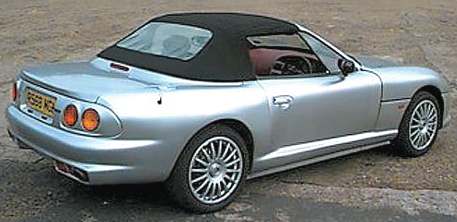
AC
Ace
|
1901
|
John
Weller, an engineer backed by John Portwine, a wealthy
tradesman, set up a small engineering workshop in South London
to build motor cars.
|
|
1903
|
A
two-cylinder 10 hp model and a four-cylinder 20 hp model were
displayed at the British Motor Show. Autocar June 6th
reported, RWe foresee a brilliant future for the Weller car
and its talented designerS.
|
|
1904
|
The
firm, then known as Autocar & Accessories Limited,
produced a commercial vehicle known as the Autocarrier. This
was a 5.6 hp air cooled single cylinder tricycle built as a
delivery vehicle P which proved successful.
|
|
1905
|
The
Autocarrier found an immediate market and became a familiar
sight. It was fashionable for firms such as Maple & Co,
Dickens & Jones and Goodyear Tyre Co to have at least one
as a delivery van. One concern ran a fleet of over 70.
|
|
1907
|
A
passenger-carrying version of the Autocarrier was made, known
as the Sociable. Its simple and practical design ensured its
production until 1915. The abbreviation AC was used for the
first time and in November a new company was formed,
Autocarriers Limited, taking over Autocar & Accessories
but with Weller and Portwine still as Directors.
|
|
1910
|
TMotor
Cycling' August shows the Autocarrier adapted for military
needs. The 25th London Cyclist Regiment was equipped with
these vehicles. Maxim guns were mounted on special bodywork
and other Autocarriers were adapted as ammunition
transporters. The Autocarrier was chosen by the military
authorities because of its reliability, lusty performance and
special manOuvrability.
|
|
1911
|
Autocarriers
Limited moved to larger premises at Thames Ditton in Surrey,
at which time Weller designed AC's first production four-wheel
car.
|
|
1914
|
During
the First World War, AC's efforts were concerned with the
manufacture of shells and fuses.
|
|
1918
|
Full
production commenced with the two-seater, four-cylinder car
which sold at #255. The cars were immediately successful in
competition, particularly in hillclimbs and early trials such
as the Land's End.
|
|
1921
|
Showrooms
and offices in London's Regent Street were opened, and racing
driver S. F. Edge joined the board of Directors. Weller and
Portwine resigned. Edge became Chairman and AC Cars Limited
was formed. The cars were sporting in character, possessed an
amazing performance and were equipped with stylish bodies
offered in a range of colours. Success in both competitive and
ordinary motoring proved the AC slogan at the time: TThe First
Light Six - and still the best'.
|
|
1922
|
Of
all AC's competition achievements, they were especially proud
of having covered one hundred miles in the hour, with a
special AC record-breaker powered by their four-cylinder, four
valve per cylinder engine. Mr J. A. Joyce drove the car at
Brooklands in November and completely shattered all the light
car records, the fastest lap being the last one at 104.85 mph.
|
|
1928
|
Seven
models were now on offer, ranging from the Aceca two-seater
coupe to a long wheelbase coachbuilt saloon. The output of the
AC six-cylinder engine increased from 40 to 56 bhp. The AC Car
Company was at this time one of Britain's largest automobile
manufacturers.
|
|
1929
|
The
World economic recession - AC Cars Limited, together with many
others of the period, went into voluntary liquidation.
|
|
1930
|
William
A. E. Hurlock and his brother, Charles F. Hurlock, purchased
the AC Car Company. No new cars were produced but servicing
facilities were maintained. Pressure from satisfied AC
customers persuaded the new Directors that there was a future
for limited production of hand-made cars for a specialist
market. Throughout the Tthirties', the AC six-cylinder engine
served faithfully in achieving tremendous results in events
such as the RAC and Monte Carlo Rallies. With showrooms in
Park Lane, London, the Company was prosperous and stable.
|
|
1931
|
The
name Ace was used for the first time.
|
|
1933
|
Four
new cars were entered in the RAC Rally, and all of them took
prizes. A four-seater sports driven by Miss Kitty Brunel
scored an outright win, Charles Hurlock took fourth place,
William Hurlock sixth and Mrs G Daniel finished seventh and
took first prize in the concours dTelegance.
|
|
1937
|
AC
found export sales in North America.
|
|
1939
|
The
outbreak of World War 2. All production facilities were turned
over to the war effort for the manufacture of fire-fighting
equipment, aircraft parts, radar vans, flame throwers, guns
and sights.
|
|
1945
|
When
war activities ceased, thoughts turned again to motor cars.
Slowly, following much development and improvement, production
grew.
|
|
1950
|
Five
cars per week were produced of the Two Litre model, which was
available in several body styles.
|
|
1953
|
The
AC Ace, an open top two-seater sports car was produced and
quickly gained a big following amongst sporting motorists. It
was highly successful in British TClub' racing, being the type
of fast, tough car that a private owner could race and rally
and still use for everyday motoring. The AC Cobra evolved from
the AC Ace .
|
|
1954
|
The
Aceca Coupe was introduced at the London Motor Show and went
into production the following year.
|
|
1957
|
Le
Mans - Ace Bristol finished tenth overall. Efforts never
concentrated solely on cars and the familiar blue invalid
carriages were turned out by the hundreds at Thames Ditton,
alongside the high powered sports cars.
|
|
1958
|
Le
Mans - Special-bodied Ace Bristol finished eighth, a standard
version ninth.
|
|
1961
|
Carroll
Shelby, a Texan ex-race driver, entered negotiations with AC
Cars and with the backing of The Ford Motor Company, proposed
the installation of a large Ford vee eight engine in the
current lightweight AC Ace. Built by AC Cars, the combination
resulted in the AC Cobra, one of the fastest and most brutal
sports cars ever produced.
|
|
1962
|
AC
Cars production concentrated on manufacturing the AC Cobra.
Each one was hand built at the factory in Thames Ditton.
|
|
1963
|
The
AC Cobra caused a sensation by racing along the M1 motorway at
196 mph, leading to questions being raised in Parliament.
Production of the AC Cobra was now 15 cars per week. The AC
plant at Taggs Island, situated half a mile from the main AC
Works, was fully occupied with the manufacture of motorised
invalid carriages for the Ministry of Health. 1,200 invalid
carriages were produced.
|
|
1964
|
Following
the motorway sprint, a 70 mph legal speed limit was
introduced. Two AC Cobras were entered in the Le Mans 24 Hour
Race, the AC entry was the first British car to finish. By
now, the 427 AC Cobra had the distinction of being listed in
the Guinness Book of Records as the fastest production car in
the world, a title which it held for several years.
|
|
1965
|
The
AC Cobra wins The Sports Car World Championship.
|
|
1967
|
AC
Cars produced the 428, a seven-litre sporting model with a
body design by Frua of Turin. 29 Convertible and 51 Fastback
vehicles were produced up to 1973, when production ceased.
|
|
1970
|
During
the 1970s and early 1980s AC developed and produced the
ME3000, a totally new mid-engined two-seater sports car.
|
|
1985
|
The
updated 5.0 litre AC Cobra is re-introduced into North
America, using the original tooling and meeting 50 State EPA
and DOT Federal Regulations.
|
|
1986
|
After
some 56 years of ownership, the Hurlock family sold their
controlling interest in AC Cars to the joint ownership of
Autokraft Limited and the Ford Motor Company. William
Hurlock's son Derek retired as Chairman. The AC Ace prototype
is displayed at the Birmingham Motor Show.
|
|
1988
|
AC
Cars moved into a new purpose-built factory of some 90,000
square feet sited within the historic Brooklands race track,
scene of so many achievements by AC Cars during the 1920s. The
AC Ace is redesigned for the 1990's sports car market.
|
|
1990
|
The
RlightweightS version of the AC Cobra is introduced.
|
|
1991
|
The
AC Ace pre-production vehicle is constructed by Autokraft. The
body styling is by International Automotive Design (IAD) of
Worthing. IAD continue to assist AC Cars in design engineering
to meet full International Certification regulations.
|
|
1992
|
Brian
Angliss personally acquires Ford's interest in AC Cars
Limited. The AC Ace is developed into its final production
form for 1993 launch. The AC Cobra Lightweight is
re-engineered to meet 1993 EEC and 49 State North American
Certification Standards. AC Cars returns to London Showrooms
after an absence of 50 years.
|
|
1993
|
The
AC Ace receives full EEC type approval and is launched at The
London Motorshow.
|
|
1994
|
The
AC Ace enters production.
|
|
1995
|
The
AC Ace unveiled to North America at the Detroit Motorshow.
|
|
1996
|
One
of the world's best known classic sports cars - the AC Cobra -
has been saved. A new company - AC Car Group Ltd - has
acquired the assets and business of the former AC Cars
company, Britain's car maker with the longest record of
continuous production.
|
This
well known classic sports car company has now been acquired by a new
company. The AC Car Group Ltd - has acquired the assets and
business of the former AC Cars company, to continue producing cars from
Britain's longest established vehicle maker. AC Car Group is based
in Weybridge, Surrey close to the historic Brooklands race track.
AC
Cars Group
Martin Hayes, Communications Advisor
(phone) 44 171 437 7955 and (fax) 44 171 437 7966 (UK).
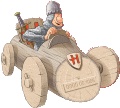
Please
click on the links above to find out about these famous automotive
makers. If your company is not included and you would like to be
listed, please let us know.
UK
VEHICLE INSURANCE ONLINE A - Z
No
matter what car, van or bike you drive, we're all looking for great
value and quality in our UK motor insurance? But who is the best
- who is the cheapest and who offers the great service in the event of
a claim?
See
the insurance companies below who claim to offer competitive cover at
sensible prices, our
guide to the jargon and tips for cutting your quote - Good
Luck:-
Automotive
Prehistory Links
CONTACTS
A
taste for adventure
capitalists
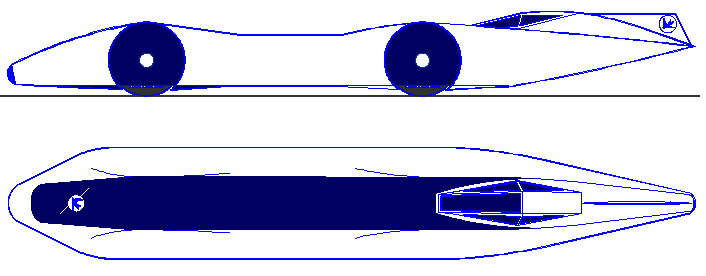
The
world's fastest electric car: 350mph + using energy from nature.
Featuring built in battery cartridge exchange, charged using renewable
solar energy. Sponsors sought for the 2016 season.
|









